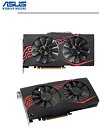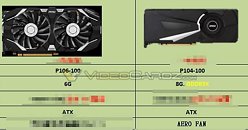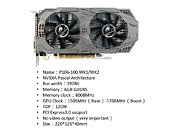Thursday, June 22nd 2017

NVIDIA "Pascal" Based Mining GPU Lineup Detailed
GPU-accelerated crypto-currency mining poses a threat to the consumer graphics industry, yet the revenues it brings to GPU manufacturers are hard to turn away. The more graphics cards are bought up by crypto-currency miners, the fewer there are left for gamers and the actual target-audience of graphics cards. This is particularly bad for AMD, as fewer gamers have Radeon graphics cards as opposed to miners; which means game developers no longer see AMD GPU market-share as an amorphous trigger to allocate developer resources in optimizing their games to AMD architectures.
To combat this, both AMD and NVIDIA are innovating graphics cards designed specifically for crypto-currency mining. These cards are built to a cost, lack display outputs, and have electrical and cooling mechanisms designed for 24/7 operation, even if not living up to the durability standards of real enterprise-segment graphics cards, such as Radeon Pro series or Quadro. NVIDIA's "Pascal" GPU architecture is inherently weaker than AMD's "Polaris" and older Graphics CoreNext architectures at Ethereum mining, owing in part to Pascal's lack of industry-standard asynchronous compute. This didn't deter NVIDIA from innovating a lineup of crypto-mining SKUs based on its existing "Pascal" GPUs. These include the NVIDIA P104 series based on the "GP104" silicon (on which the GTX 1080 and GTX 1070 are based); and P106 series based on the "GP106" silicon (GTX 1060 series is based on this chip). NVIDIA didn't tap into its larger "GP102" or smaller "GP107" chips, yet.VideoCardz compiled a small list of unreleased crypto-currency mining cards based on the P104 and P106. These include cards from popular NVIDIA GeForce add-in card (AIC) partners, such as ASUS, MSI, and Colorful. The mining-segment cards look almost identical to the GeForce GTX 10-series cards they're derived from; but lack display outputs. Pictured above are the ASUS MINING-P106-6G, MSI P106-Miner, MSI P104-Miner; and Colorful P106-100 WK1 (in that order). It remains to be seen how NVIDIA and its partners price these cards, but if they're pricier than their GeForce GTX siblings, this whole exercise will be rendered futile, as miners will simply buy up the GeForce GTX inventories.
Source:
VideoCardz
To combat this, both AMD and NVIDIA are innovating graphics cards designed specifically for crypto-currency mining. These cards are built to a cost, lack display outputs, and have electrical and cooling mechanisms designed for 24/7 operation, even if not living up to the durability standards of real enterprise-segment graphics cards, such as Radeon Pro series or Quadro. NVIDIA's "Pascal" GPU architecture is inherently weaker than AMD's "Polaris" and older Graphics CoreNext architectures at Ethereum mining, owing in part to Pascal's lack of industry-standard asynchronous compute. This didn't deter NVIDIA from innovating a lineup of crypto-mining SKUs based on its existing "Pascal" GPUs. These include the NVIDIA P104 series based on the "GP104" silicon (on which the GTX 1080 and GTX 1070 are based); and P106 series based on the "GP106" silicon (GTX 1060 series is based on this chip). NVIDIA didn't tap into its larger "GP102" or smaller "GP107" chips, yet.VideoCardz compiled a small list of unreleased crypto-currency mining cards based on the P104 and P106. These include cards from popular NVIDIA GeForce add-in card (AIC) partners, such as ASUS, MSI, and Colorful. The mining-segment cards look almost identical to the GeForce GTX 10-series cards they're derived from; but lack display outputs. Pictured above are the ASUS MINING-P106-6G, MSI P106-Miner, MSI P104-Miner; and Colorful P106-100 WK1 (in that order). It remains to be seen how NVIDIA and its partners price these cards, but if they're pricier than their GeForce GTX siblings, this whole exercise will be rendered futile, as miners will simply buy up the GeForce GTX inventories.




54 Comments on NVIDIA "Pascal" Based Mining GPU Lineup Detailed
- SSH
- VNC
- Serial console
that it doesn't play well in the FOSS
environment.
Make those drivers open source, and I'd bet
nVidia would be MADE competitive by the
FOSS community.
The unit price for a pack of 1000 is the same as you paid two monts ago for the cheapest GTX 1060 6GB, and you need to pay 25% in advance. The card will be delivered in 40 to 60 days from now.
I am glad I replaced my ONE MONTH OLD RX480 (second hand) with a new 1070, it was the last day the 1070 was available in stores for a decent price. I will keep this one until the mining insanity will settle down.
I'm waiting to see some hack that allows these cards to render games while some other video device (like an Intel iGPU) simply passes along the picture to the monitor.
At the moment Pascal cards are available at (1050/1050Ti) or over (1600 and up) their launch prices.
Is NVIDIA even interested in releasing anything new? 2050 was going to be a refresh anyway.
I just don't see this mining conundrum ending without a huge collapse of profitability or a forced limit on GPU's mining efficiency.
Would it be even possible for NVIDIA to make normal cards unusable for mining? Technically - maybe yes, but that would be a reputation issue for sure....
And it's even worse in AMD camp.
I'm ordering a 1050Ti today. It's 20% more expensive than 2 months ago (damn ;-(), but some stores are already selling it for another +30%. It seems to be the last moment...
Mining isn't going anywhere. It's here to stay, like it or not.I highly doubt anyone buys a Ryzen for a mining rig.